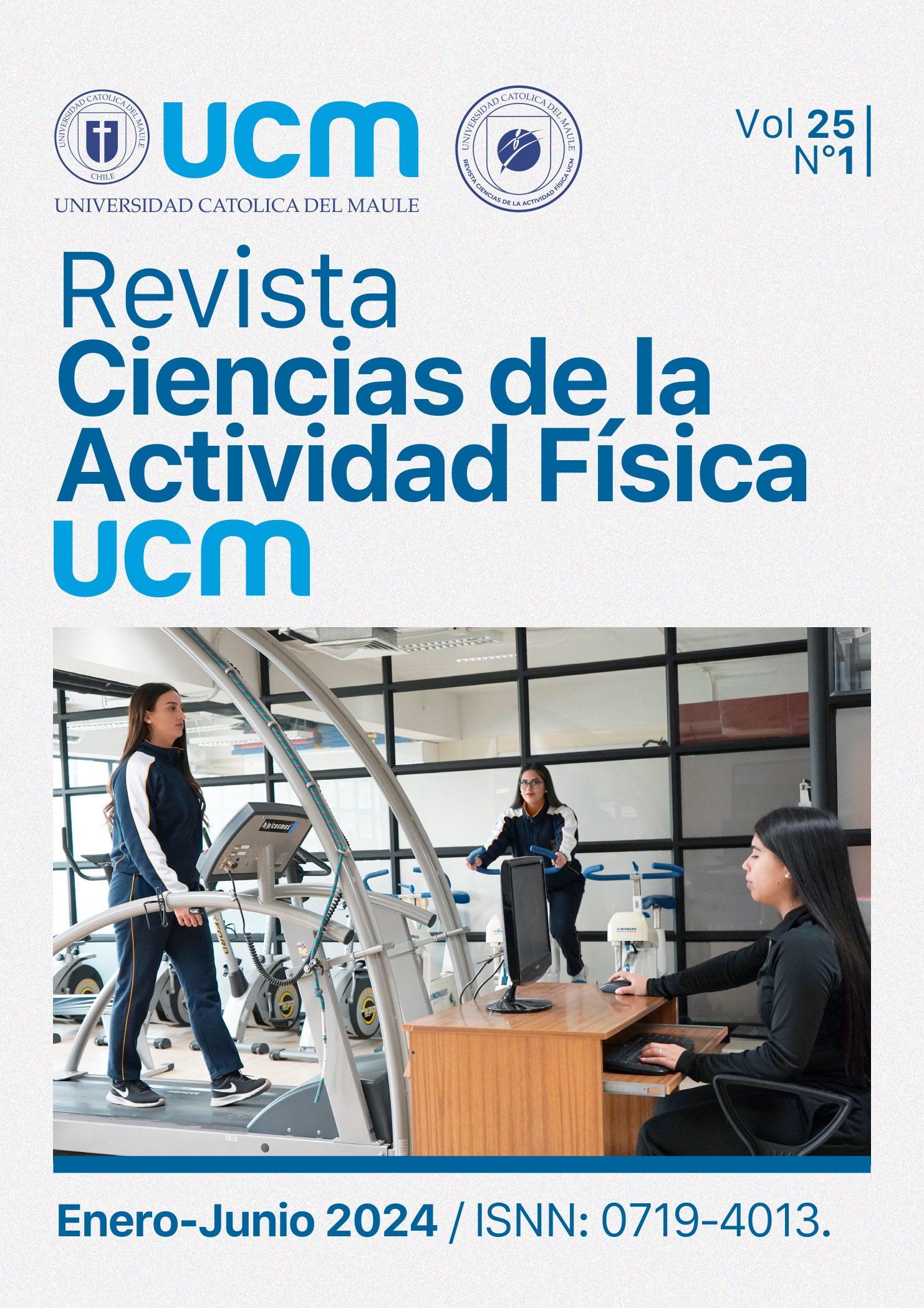Ayala, V., Martínez-Bebia, M., Latorre, J. A., Gimenez-Blasi, N., Jimenez-Casquet, M. J., Conde-Pipo, J., Bach-Faig, A., & Mariscal-Arcas, M. (2021). Influence of circadian rhythms on sports performance. Chronobiology International, 38(11), 1522–1536. https://doi.org/10.1080/07420528.2021.1933003
Böhme, M. T. S. (1993). Aptidão física - aspectos teóricos. Revista Paulista de Educação Física, 7(2), 52-65. https://doi.org/10.11606/issn.2594-5904.rpef.1993.138757
Borg, G. A. V. (1982). Psychophysical bases of perceived exertion. Medicine & Science in Sports & Exercise, 4(5), 377-381. http://dx.doi.org/10.1249/00005768-198205000-00012
Chapman, M., Larumbe-Zabala, E., Goss-Sampson, M., Triplett, N. T., & Naclerio, F. (2019). Using perceptual and neuromuscular responses to estimate mechanical changes during continuous sets in the bench press. The Journal of Strength & Conditioning Research, 33(10): 2722-2732. https://doi.org/10.1519/jsc.0000000000002516
Chtourou, H., Engel, F. A., Fakhfakh, H., Fakhfakh, H., Hammouda, O., Ammar, A., Trabelsi, K., Souissi, N., & Sperlich, B. (2018). Diurnal variation of short-term repetitive maximal performance and psychological variables in elite judo athletes. Frontiers in Physiology, 9, 1499. https://doi.org/10.3389/fphys.2018.01499
Deschenes, M. R., Kraemer, W. J., Bush, J. A., Doughty, T. A., Kim, D., Mullen, K. M., & Ramsey, K. (1998). Biorhythmic influences on functional capacity of human muscle and physiological responses. Medicine and science in sports and exercise, 30(9), 1399-1407. https://doi.org/10.1249/00005768-199809000-00008
Fuller, P. M., Gooley, J. J., & Saper, C. B. (2006). Neurobiology of the sleep-wake cycle: sleep architecture, circadian regulation, and regulatory feedback. Journal of Biological Rhythms, 21(6), 482-493. https://doi.org/10.1177/0748730406294627
Grgic, J., Lazinica, B., Garofolini, A., Schoenfeld, B. J., Saner, N. J., & Pavle Mikulic, P. (2019). The effects of time of day-specific resistance training on adaptations in skeletal muscle hypertrophy and muscle strength: A systematic review and meta-analysis. Chronobiology International, 36(4), 449-460. https://doi.org/10.1080/07420528.2019.1567524
Guedes, D. P., & Guedes, E. R. P. (2006). Manual prático para avaliação em Educação Física. Manole.
Hey, L. F., Souza, D. C., Nunhes, P. M., Marchini, K. B., Trindade, M. C., & Avelar, A. (2020). O período do dia não influencia o desempenho físico de homens praticantes de treinamento com pesos. Saúde e Pesquisa, 13(1), 157-165. https://doi.org/10.17765/2176-9206.2020v13n1p157-165
Johnson, B. L., & Nelson, J. K. (1979). Pratical Measurements for Evaluation in Physical Education. Burgess Publishing.
Lima, S. P. R., Navarro, F., & Viana, V. A. R. (2008). O teste de aptidão física para os bombeiros militares da ativa, sem restrições médicas, do corpo de bombeiros militar do distrito federal. Revista Brasileira de Prescrição e Fisiologia do Exercício, 2(8), 158-176. http://dx.doi.org/10.13140/rg.2.1.3332.1041
Matsudo, S., Araújo, T., Matsudo, V., Andrade, D., Andrade, E., Oliveira, L. C., & Braggion, G. (2012). Questionário Internacional De Atividade Física (IPAQ): Estudo de validade e reprodutibilidade no Brasil. Revista Brasileira De Atividade Física & Saúde, 6(2), 5-18. https://rbafs.org.br/RBAFS/article/view/931
Mendonça, R. (2019) Distúrbios do ciclo circadiano: um estudo sobre o Jet Lag. Ciências Aeronáuticas-Unisul Virtual. https://repositorio.animaeducacao.com.br/items/7428ab57-a5c4-43d4-95cb-f28a4155d41c
Minati, A., de Santana, M. G., & de Mello, M. T. (2006). A influência dos ritmos circadianos no desempenho físico. Revista Brasileira de Ciência e Movimento, 14(1), 75-86. https://portalrevistas.ucb.br/index.php/rbcm/article/view/681
Moura, J. A. R., Peripolli, J, & Zinn, J. L. (2003). Comportamento da percepção subjetiva de esforço em função da força dinâmica submáxima em exercícios resistidos com pesos. Revista Brasileira de Fisiologia do Exercício, 2(2), 110-122. https://www.researchgate.net/publication/291701837_Comportamento_da_percepcao_subjetiva_de_esforco_
em_funcao_da_forca_dinamica_submaxima_em_exercicios_resistidos_com_pesos
Nahas, M. V. (2001). Atividade física, saúde e qualidade de vida. Midiograf.
Oliveira Pedroso, C., Saldanha, R. P., & Da Silva, E. R. (2013). Análise da produção máxima de força muscular em 24 horas: efeitos circadianos. Saúde e Desenvolvimento Humano, 1(1), 39-47. https://revistas.unilasalle.edu.br/index.php/saude_desenvolvimento/article/view/1025/0
Ritti-Dias, R., Trape, Átila A., Farah, B. Q., Petreça, D. R., Lemos, E. C. de., Carvalho, F. F. B. de., Magalhães, L. L., Maciel, M. G., Gomes, P. S. C., Manta, S. W., Hallal, P. C., & Andrade, D. R. (2021). Atividade física para adultos: Guia de Atividade Física para a População Brasileira. Revista Brasileira De Atividade Física & Saúde, 26, 1–11. https://doi.org/10.12820/rbafs.26e0215
Roschel, H., Tricoli, V., & Ugrinowitsch, C. (2011). Treinamento físico: considerações práticas e científicas. Revista Brasileira De Educação Física E Esporte, 25(spe), 53–65. https://doi.org/10.1590/s1807-55092011000500007
Schoenell, M. C. W., Tiggemann, C. L., Cadore, E. L., Tartaruga, M. P., & Kruel, L. F. M. (2013). Correlação e reprodutibilidade de testes abdominais em mulheres jovens. Revista Brasileira de Ciências do Esporte, 35(3), 561-574. https://doi.org/10.1590/s0101-32892013000300003
Shephard, R. J., & Balady, G. J. (1999). Exercise as Cardiovascular Therapy. Circulation, 99(7), 963–72. https://doi.org/10.1161/01.CIR.99.7.963


 https://orcid.org/0009-0009-0563-6714
https://orcid.org/0009-0009-0563-6714
